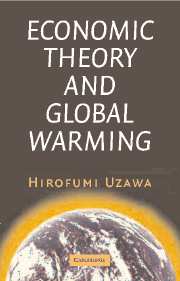Refine listing
Actions for selected content:
2285 results in Ebooks in ecology and environment
4 - Effects of free allocation
-
- Book:
- Pricing Carbon
- Published online:
- 05 July 2011
- Print publication:
- 28 January 2010, pp 85-121
-
- Chapter
- Export citation
List of boxes
-
- Book:
- Pricing Carbon
- Published online:
- 05 July 2011
- Print publication:
- 28 January 2010, pp xiii-xiii
-
- Chapter
- Export citation

Economic Theory and Global Warming
-
- Published online:
- 03 December 2009
- Print publication:
- 14 August 2003

Adjudicating Climate Change
- State, National, and International Approaches
-
- Published online:
- 25 August 2009
- Print publication:
- 27 July 2009
16 - The Implications of Climate Change Litigation: Litigation for International Environmental Law-Making
-
-
- Book:
- Adjudicating Climate Change
- Published online:
- 25 August 2009
- Print publication:
- 27 July 2009, pp 357-374
-
- Chapter
- Export citation
6 - The Intersection of Scale, Science, and Law in Massachusetts v. EPA
-
-
- Book:
- Adjudicating Climate Change
- Published online:
- 25 August 2009
- Print publication:
- 27 July 2009, pp 129-144
-
- Chapter
- Export citation
9 - Tort-Based Climate Litigation
-
-
- Book:
- Adjudicating Climate Change
- Published online:
- 25 August 2009
- Print publication:
- 27 July 2009, pp 193-229
-
- Chapter
- Export citation
Index
-
- Book:
- Adjudicating Climate Change
- Published online:
- 25 August 2009
- Print publication:
- 27 July 2009, pp 387-399
-
- Chapter
- Export citation
1 - Overview: The Exigencies That Drive Potential Causes of Action for Climate Change
-
-
- Book:
- Adjudicating Climate Change
- Published online:
- 25 August 2009
- Print publication:
- 27 July 2009, pp 1-28
-
- Chapter
- Export citation
Acknowledgments
-
- Book:
- Adjudicating Climate Change
- Published online:
- 25 August 2009
- Print publication:
- 27 July 2009, pp ix-x
-
- Chapter
- Export citation
PART I - SUBNATIONAL CASE STUDIES
-
-
- Book:
- Adjudicating Climate Change
- Published online:
- 25 August 2009
- Print publication:
- 27 July 2009, pp 29-30
-
- Chapter
- Export citation
5 - Atmospheric Trust Litigation
-
-
- Book:
- Adjudicating Climate Change
- Published online:
- 25 August 2009
- Print publication:
- 27 July 2009, pp 99-126
-
- Chapter
- Export citation
14 - Potential Causes of Action for Climate Change Impacts under the United Nations Fish Stocks Agreement
-
-
- Book:
- Adjudicating Climate Change
- Published online:
- 25 August 2009
- Print publication:
- 27 July 2009, pp 314-333
-
- Chapter
- Export citation
PART III - SUPRANATIONAL CASE STUDIES
-
-
- Book:
- Adjudicating Climate Change
- Published online:
- 25 August 2009
- Print publication:
- 27 July 2009, pp 253-254
-
- Chapter
- Export citation
15 - Climate Change Litigation: Opening the Door to the International Court of Justice
-
-
- Book:
- Adjudicating Climate Change
- Published online:
- 25 August 2009
- Print publication:
- 27 July 2009, pp 334-356
-
- Chapter
- Export citation
11 - The World Heritage Convention and Climate Change: The Case for a Climate-Change Mitigation Strategy beyond the Kyoto Protocol
-
-
- Book:
- Adjudicating Climate Change
- Published online:
- 25 August 2009
- Print publication:
- 27 July 2009, pp 255-271
-
- Chapter
- Export citation
Contents
-
- Book:
- Adjudicating Climate Change
- Published online:
- 25 August 2009
- Print publication:
- 27 July 2009, pp v-vi
-
- Chapter
- Export citation
13 - Bringing Climate Change Claims to the Accountability Mechanisms of International Financial Institutions
-
-
- Book:
- Adjudicating Climate Change
- Published online:
- 25 August 2009
- Print publication:
- 27 July 2009, pp 292-313
-
- Chapter
- Export citation
8 - An Emerging Human Right to Security from Climate Change: The Case Against Gas Flaring in Nigeria
-
-
- Book:
- Adjudicating Climate Change
- Published online:
- 25 August 2009
- Print publication:
- 27 July 2009, pp 173-192
-
- Chapter
- Export citation
12 - The Inuit Petition as a Bridge? Beyond Dialectics of Climate Change and Indigenous Peoples' Rights
-
-
- Book:
- Adjudicating Climate Change
- Published online:
- 25 August 2009
- Print publication:
- 27 July 2009, pp 272-291
-
- Chapter
- Export citation
